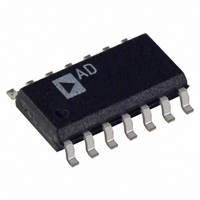OP462GSZ Analog Devices Inc, OP462GSZ Datasheet - Page 12

OP462GSZ
Manufacturer Part Number
OP462GSZ
Description
IC OPAMP GP R-R 15MHZ LN 14SOIC
Manufacturer
Analog Devices Inc
Type
General Purpose Amplifierr
Datasheet
1.OP162GSZ.pdf
(20 pages)
Specifications of OP462GSZ
Slew Rate
13 V/µs
Amplifier Type
General Purpose
Number Of Circuits
4
Output Type
Rail-to-Rail
Gain Bandwidth Product
15MHz
Current - Input Bias
260nA
Voltage - Input Offset
25µV
Current - Supply
550µA
Current - Output / Channel
30mA
Voltage - Supply, Single/dual (±)
2.7 V ~ 12 V, ±1.35 V ~ 6 V
Operating Temperature
-40°C ~ 125°C
Mounting Type
Surface Mount
Package / Case
14-SOIC (3.9mm Width), 14-SOL
Op Amp Type
Low Power
No. Of Amplifiers
4
Bandwidth
15MHz
Supply Voltage Range
2.7V To 12V
Amplifier Case Style
SOIC
No. Of Pins
14
Rail/rail I/o Type
Rail to Rail Output
Number Of Elements
4
Unity Gain Bandwidth Product
15MHz
Common Mode Rejection Ratio
70dB
Input Offset Voltage
325uV
Input Bias Current
600nA
Single Supply Voltage (typ)
3/5/9V
Dual Supply Voltage (typ)
±3/±5V
Voltage Gain In Db
98.89dB
Power Supply Rejection Ratio
120dB
Power Supply Requirement
Single/Dual
Shut Down Feature
No
Single Supply Voltage (min)
2.7V
Single Supply Voltage (max)
12V
Dual Supply Voltage (min)
±1.35V
Dual Supply Voltage (max)
±6V
Technology
BiCOM
Operating Temp Range
-40C to 125C
Operating Temperature Classification
Automotive
Mounting
Surface Mount
Pin Count
14
Package Type
SOIC N
Lead Free Status / RoHS Status
Lead free / RoHS Compliant
-3db Bandwidth
-
Lead Free Status / Rohs Status
Compliant
Available stocks
Company
Part Number
Manufacturer
Quantity
Price
Part Number:
OP462GSZ
Manufacturer:
ADI/亚德诺
Quantity:
20 000
Part Number:
OP462GSZ-REEL
Manufacturer:
ADI/亚德诺
Quantity:
20 000
Part Number:
OP462GSZ-REEL7
Manufacturer:
ADI/亚德诺
Quantity:
20 000
OP162/OP262/OP462
APPLICATIONS
FUNCTIONAL DESCRIPTION
The OPx62 family is fabricated using Analog Devices’ high
speed complementary bipolar process, also called XFCB. This
process trench isolates each transistor to lower parasitic capaci-
tances for high speed performance. This high speed process has
been implemented without sacrificing the excellent transistor
matching and overall dc performance characteristic of Analog
Devices’ complementary bipolar process. This makes the OPx62
family an excellent choice as an extremely fast and accurate low
voltage op amp.
Figure 33 shows a simplified equivalent schematic for the OP162.
A PNP differential pair is used at the input of the device. The
cross connecting of the emitters lowers the transconductance of
the input stage improving the slew rate of the device. Lowering
the transconductance through cross connecting the emitters has
another advantage in that it provides a lower noise factor than if
emitter degeneration resistors were used. The input stage can
function with the base voltages taken all the way to the negative
power supply, or up to within 1 V of the positive power supply.
Two complementary transistors in a common-emitter
configuration are used for the output stage. This allows the
output of the device to swing to within 50 mV of either supply
rail at load currents less than 1 mA. As load current increases,
the maximum voltage swing of the output decreases. This is due
to the collector-to-emitter saturation voltages of the output
transistors increasing. The gain of the output stage, and conse-
quently the open-loop gain of the amplifier, is dependent on the
load resistance connected at the output. Because the dominant pole
frequency is inversely proportional to the open-loop gain, the
unity-gain bandwidth of the device is not affected by the load
resistance. This is typically the case in rail-to-rail output
devices.
+IN
–IN
V
V
CC
EE
Figure 33. Simplified Schematic
Rev. F | Page 12 of 20
V
OUT
OFFSET ADJUSTMENT
Because the OP162/OP262/OP462 have an exceptionally low
typical offset voltage, adjustment to correct offset voltage may
not be needed. However, the OP162 has pinouts to attach a
nulling resistor. Figure 34 shows how the OP162 offset voltage
can be adjusted by connecting a potentiometer between Pin 1
and Pin 8, and connecting the wiper to V
avoid accidentally connecting the wiper to V
the device. The recommended value for the potentiometer is
20 kΩ.
RAIL-TO-RAIL OUTPUT
The OP162/OP262/OP462 have a wide output voltage range
that extends to within 60 mV of each supply rail with a load
current of 5 mA. Decreasing the load current extends the output
voltage range even closer to the supply rails. The common-mode
input range extends from ground to within 1 V of the positive
supply. It is recommended that there be some minimal amount
of gain when a rail-to-rail output swing is desired. The minimum
gain required is based on the supply voltage and can be found as
where V
voltage of 5 V, the minimum gain to achieve rail-to-rail output
should be 1.25.
OUTPUT SHORT-CIRCUIT PROTECTION
To achieve a wide bandwidth and high slew rate, the output of
the OP162/OP262/OP462 are not short-circuit protected. Shorting
the output directly to ground or to a supply rail may destroy the
device. The typical maximum safe output current is ±30 mA.
Steps should be taken to ensure the output of the device will not
be forced to source or sink more than 30 mA.
In applications where some output current protection is needed,
but not at the expense of reduced output voltage headroom, a
low value resistor in series with the output can be used. This is
shown in Figure 35. The resistor is connected within the feed-
back loop of the amplifier so that if V
A
V,min
S
is the positive supply voltage. With a single-supply
=
V
V
S
Figure 34. Offset Adjustment Schematic
S
−
1
3
2
1
OP162
8
20kΩ
+5V
–5V
7
4
6
OUT
is shorted to ground
CC
EE
. It is important to
, as this can damage
V
OS













